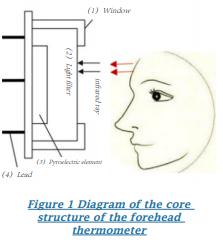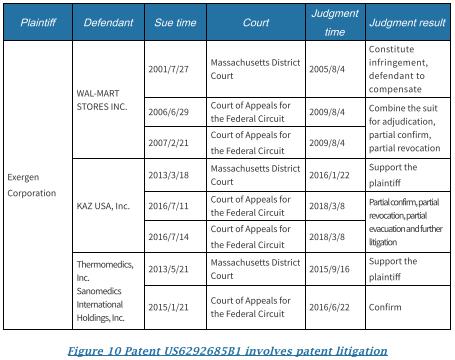"Fever" is the primary clinical manifestation of pneumonia cases infected by COVID-19. Therefore, body temperature measurement has become a very important means for the initial screening of COVID-19 cases. Relying on the advantages of non-contact, fast measurement, and avoiding cross-infection, the forehead thermometer has become the preferred temperature measurement tool during the epidemic. For a while, police officers and security guards can be seen everywhere, holding forehead thermometer to check the temperature of passengers, customers, owners, etc. in stations, highways, supermarkets, shopping malls, and community gates. With the surge in demand, forehead thermometers have quickly become another "out of stock king" after masks.
The origin and principle of infrared temperature measurement technology
The core technology of the forehead thermometer is infrared temperature measurement technology.From the first discovery of infrared by humans in 1800 to the proposal of Kirchhoff's radiation law in 1859 to the concept of the absolute black body in 1862, and later Boltzmann, Wien, Planck and other scientists' related research, these theories and studies have laid a solid theoretical foundation for the development of infrared technology. Infrared temperature measurement has also developed from this. Infrared temperature measurement was first used in general industrial fields. As the defects of mercury thermometers were discovered,infrared thermometers began to develop gradually. With the outbreak of the SARS virus in 2003, the advantages of non-contact and rapid measurement of infrared thermometers have received widespread attention,and infrared thermometers have been rapidly developed in the field of medical care [Su Jiankui, Gui Xingyu, 2016. Current Status And Development Of Medical Infrared Body Temperature Measuring Instruments [J]. Medical and Medical Equipment, Volume 37, Issue 1.].
The core structure of the forehead thermometer is shown in the figure below.
The measurement principle is the infrared radiation from the human forehead reaches the filter through the measurement window, and then reaches the pyroelectric element after being filtered by the filter. The pyroelectric element sends the heat signal (infrared) is converted into electrical signals, and then output to the processor for processing and calculation to obtain the temperature of the human forehead.
The evolution of patent technology of forehead thermometer
In the Incopat database, the author used the key words "infrared", "forehead thermometer", “forehead” or “frontal part” to search in combination with the classification number A61B5/01. Preliminary screening and combination of application numbers were carried out and finally obtained 213 related patent documents.
After reading and analyzing those mentioned above 213 related patent documents, the author found that in the early application, the patent with the publication number US6292685B1 has the characteristics of a large number of patent families, a wide range of layout, and a large number of citations. Among them, the patent has ten simple patent families, distributed in the United States, Europe, Australia, Japan and Austria, the number of citations of the family is 125 times, these data are enough to show that the patent's status in the field of forehead thermometer should not be underestimated.
The author conducted a detailed analysis of the patent. The patent US6292685B1 was applied for in 1998. The applicant is the Exergen Company of the United States, and the invention name is "A Temporal Artery Temperature Detector". In order to solve the problem of inconvenient measurement of the existing infrared ear thermometer and infrared axillary thermometer, especially for the technical issue of inconvenient measurement for newborns, infants and young children, this patent provides a temporal artery temperature detector whose measurement site is the forehead. The detector includes a thermal radiation sensor, and when in use, the temperature measuring probe contacts the skin of the temporal artery of the subject. The patent also records that since the temperature detector uses contact measurement, it may cause cross-infection. In order to avoid cross-infection, the temperature detector can be equipped with a disposable transparent cover. Compared with an infrared armpit thermometer and an infrared ear thermometer, the infrared forehead thermometer has a significant advantage of convenient measurement. The main drawings of the patent are shown in Figure 3:

After continuing to analyze the patent documents after the patent US6292685B1, the author found that following this patent, the patent technology of forehead thermometer has developed rapidly. From 1998 to 2002, the number of patent applications for forehead thermometer is shown in Figure 4:
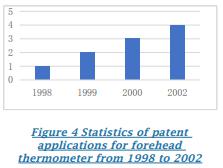
Most of these patents are related to the improvement of the structure of the forehead thermometer, especially the structure improvement of the temperature measuring probe. Among them, the patent/patent applications WO0016046A2, TW463038B, US6789936B1, JP2001029317A, US20020181540A1 and US20030016728A1 are all aimed at the structure of the temperature measuring probe. The improvement enables the forehead thermometer to have at least two probe structures, which are suitable for forehead temperature detection and ear temperature detection respectively. Only the patent KR1020030074885A is aimed at the improvement of the data processing algorithm of the forehead thermometer, and its typical drawings are shown in Figure 5:
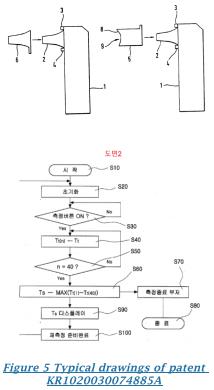
The temperature measurement methods used in the above mentioned forehead thermometer patents are still contacted measurement, and there is still the problem of cross-infection. Although the use of a disposable transparent cover can avoid cross infection, it leads to an increase in cost. Moreover, when measuring a large number of people, it will also increase the complexity of the operation.
With the outbreak of the SARS virus in 2003, the problems caused by the contact measurement method of forehead thermometer were also exposed. Since 2003, domestic research on forehead thermometer technology has gradually developed. The author used the classification numbers a61b5/01/ic and g01k11/ ic in the CNTXT database of the s system for domestic patent applications from 1999 to 2008 and combined the keywords “infrared", "forehead thermometer”, “forehead” or “frontal part” and searched, and eliminate obvious noise in the search results. The results showed that there were only sporadic applications from 1999 to 2002. Since 2003, the number of applications has increased significantly. Among them, the number of applications in 2003 was eight, and the cumulative number of applications from 2003 to 2008 was 24.
The author further used .stat in the s system to calculate the frequency of applicants for patent applications from 2003 to 2008. According to the statistical results, the Chinese applicant with the highest frequency of applicants was the Shenzhen Tsinghua University Research Institute. The author conducted a search on the patent application of Shenzhen Tsinghua University Research Institute in the field of the forehead thermometer and found that it applied for two invention patents on non-contact infrared temperature measurement at the same time on April 20, 2003, and both were granted. The grant announcement numbers are CN1329717C and CN1329716C respectively. The core concepts of these two patents are relatively similar. They are aimed at the technical problems of unhygienic contact temperature measuring instruments and easy to cause cross-infection. A non-contact infrared temperature measuring instrument is provided, which is safely used for rapid temperature detection of a large number of people. The same family of these two patents has been cited 24 times. Among them, the patent CN1329717C focuses on the internal structure and measurement principle of the infrared body temperature detector,and the patent CN1329716C focuses on the temperature measurement scene of the infrared body temperature detector and its setting method in the temperature measurement scene.
The author conducted a detailed analysis of the patent CN1329717C, which focuses on the principle of infrared temperature measurement. The patent’s invention is titled "Positioning non-contact infrared body temperature detection instrument and body temperature detection method". The body temperature detector described in the patent measures temperature without the probe touching the skin of the subject; that is, there is a certain distance between the foreheads and the probe. As we all know, in the transmission process of infrared rays, as the distance increases, its energy will correspondingly attenuate. Then, when there is a certain distance between the probe and the subject’s forehead, the energy of the infrared rays transmitted to the probe will inevitably be less than that of the probe. The actual infrared energy radiated by the person’s forehead will cause inaccurate measurement results. In order to overcome this problem, the patent improves the existing temperature measurement algorithm and introduces a distance compensation method. Through this method, the energy attenuation caused by the transmission distance can be compensated to ensure the accuracy of the measurement result. The main drawings of the patent are shown in Figure 6:

Following this patent, the technology of the non-contact forehead thermometer has been developed rapidly. Subsequent patents mainly involve improvements in the display, shape, portability, data processing, and data transmission of the forehead thermometer. The technology is becoming more mature and perfect. For example, for patents/patent applications TWI369482B, US20090125330A1, US 20090054785A1 , US20130096437A1, typical drawings are shown in Figure 7:
Overview of Exergen, an important patent applicant in the field of forehead thermometers
From the foregoing analysis, we can see that the applicant for the important patent US6292685B1 in the field of forehead thermometer is Exergen Corporation. You may be curious about who is Exergen Corporation?
Exergen Corporation is a recognized world-leading supplier of non-invasive temperature technology for industry and medicine. It was established by Harvard University research scientist Dr. Francesco Pompei (inventor of the aforementioned patent US6292685B1) more than 20 years ago. The company's headquarters is located in Massachusetts, United States. Exergen provides temperature sensors for NASA and various manufacturing industries, as well as lower cost, higher precision, and more reliable temperature measurement equipment. Its thermometer products are allowed to be used in retail medical applications. Exergen's main products include tympanic thermometer, LXN neonatal, DermaTemp, disposable covers and sheaths, accessories, OtoTemp TM veterinary, calibration verification kit, etc. Its recommended products are shown in Figure 8:
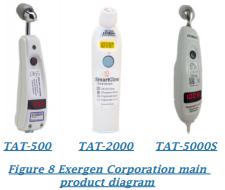
The TAT-500 in Figure 8 is the actual product of the aforementioned patent US6292685B1; TAT-5000S is an upgraded product of TAT500; TAT-2000 is a temporal artery frontal thermometer especially suitable for infants and young children. It can be seen that Exergen still occupies a pivotal position in the field of infrared thermometers. What about the patent application and protection of such a company focusing on infrared temperature measurement?
In the Incopat database, the author used the applicant or assignee as the entrance and used "Exergen Corporation" as the input to search, and merged the application numbers, and finally obtained 98 related patent documents. Among them, among the six patents of which Exergen is the assignee, the assignor of five patents is Francesco Pompei (the founder of Exergen), and one patent (US5991645A, wireless phone headset with automatic login/ logout detection) The transferor of the headset system is GN NETCOM INC (Great Nordic Communication Design Co., Ltd., a leading headset and microphone manufacturer). Through analyzing the application trends of the 98 related patents mentioned above, it is concluded that Exergen's patent application status is shown in Figure 9:
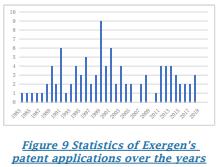
It can be seen from Figure 9 that from 1983 to 2018, Exergen had patent applications basically every year. Among them, the number of applications from 1989 to 2003 was relatively large, the number of applications from 2011 to 2018 was relatively stable, and the number of applications in 2019 was 0 (It may be because the patents applied for in 2019 have not been published). The application trends of Exergen from 1983 to 2018 show that the company pays more attention to technology research and development, and its core technology is constantly developing and improving.
The author further analyzed the legal events involved in the above 98 related patents. A total of 17 patents were involved in litigation, among them, 12 involved infringement litigation, six involved other litigation, and five involved administrative litigation. Many of these patents had many litigations and long duration of the litigation. Take the patent US6292685B1 as an example, the patent experienced eight infringement lawsuits during 2001-2018, involving four defendants, namely WALMART STORES INC., KAZ USA, Inc., Thermomedics, Inc. and Sanomedics Figure 10 Patent US6292685B1 involves patent litigation International Holdings, Inc. The specific litigation information is shown in Figure 10:
From the analysis of the above legal events, it can be seen that Exergen's patents are very active, which shows that Exergen attaches great importance to the protection and use of its patents. Only when a patent is active can its value be fully realized.
To sum up, Exergen attaches great importance to a patent application and its protection and operation and has invested enough energy, which is also an important factor for its long-lasting position in the industry for more than 20 years.
Comparison between US6292685B1 and CN1329717C
From the foregoing analysis, it can be seen that US6292685B1 is a key patent in the field of forehead thermometer applied by Exergen. The application date is September 11, 1998, and the grant announcement date is September 18, 2001. The inventor is Harvard University research scientist Dr. Francesco Pompei. The patent has undergone eight infringement lawsuits from 2001 to 2018, which is quite active. The patent realizes the transformation of scientific and technological achievements, has a product in kind, and its product is one of Exergen's main products.
CN1329717C is a typical non-contact forehead thermometer patent applied by Shenzhen Tsinghua University Research Institute. The application date is April 20, 2003, and the authorization announcement date is August 1, 2007. The inventor is Feng Guanping, a doctoral supervisor at Tsinghua University. The patent was granted to Shenzhen Healthscale Electronic Technology Co., Ltd. as an exclusive license on November 10, 2010. The author did not retrieve related products from limited search resources. The patent was terminated on June 11, 2014, due to non-payment of annual fees.
It can be found that the two patents have obvious similarities when comparing the situation of them: both are key patents in the field of the forehead thermometer and have important representative significance; the inventors of both are scientists from world-renowned universities. It can be seen that research in universities usually focuses on relatively cutting-edge technologies. However, the outcome of the above two patents is not the same. The reason is that the patent CN1329717C did not smoothly realize the transformation of scientific and technological achievements, and was relatively lacking in protection and operation so that it failed to become active and thus failed to exert its value. In contrast, Exergen has more reference value in patent protection and operation.

